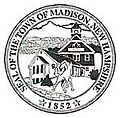Geography
According to the United States Census Bureau, the town has a total area of 40.9 square miles (105.9 km2), of which 38.5 square miles (99.7 km2) are land and 2.4 square miles (6.2 km2) are water, comprising 5.84% of the town. [1]
Madison is drained by Forrest Brook and Silver Lake to the south and by Pequawket Brook to the north. [5] The entire town is part of the Saco River watershed. The highest point in Madison is the summit of Lyman Mountain in the eastern part of the town, at 1,558 feet (475 m) above sea level. [6]
Demographics
As of the census [8] of 2000, there were 1,984 people, 777 households, and 560 families residing in the town. The population density was 51.2 inhabitants per square mile (19.8/km2). There were 1,589 housing units at an average density of 41.0 per square mile (15.8/km2). The racial makeup of the town was 97.78% White, 0.05% African American, 0.66% Native American, 0.20% Asian, 0.40% from other races, and 0.91% from two or more races. Hispanic or Latino of any race were 0.76% of the population.
There were 777 households, out of which 33.1% had children under the age of 18 living with them, 60.0% were married couples living together, 7.2% had a female householder with no husband present, and 27.9% were non-families. 21.5% of all households were made up of individuals, and 7.9% had someone living alone who was 65 years of age or older. The average household size was 2.55 and the average family size was 2.97.
In the town, the population was spread out, with 24.8% under the age of 18, 5.4% from 18 to 24, 31.1% from 25 to 44, 26.6% from 45 to 64, and 12.0% who were 65 years of age or older. The median age was 40 years. For every 100 females, there were 104.3 males. For every 100 females age 18 and over, there were 99.2 males.
The median income for a household in the town was $43,523, and the median income for a family was $51,080. Males had a median income of $32,422 versus $22,159 for females. The per capita income for the town was $20,608. About 2.0% of families and 4.5% of the population were below the poverty line, including 5.2% of those under age 18 and 3.8% of those age 65 or over.
This page is based on this
Wikipedia article Text is available under the
CC BY-SA 4.0 license; additional terms may apply.
Images, videos and audio are available under their respective licenses.




